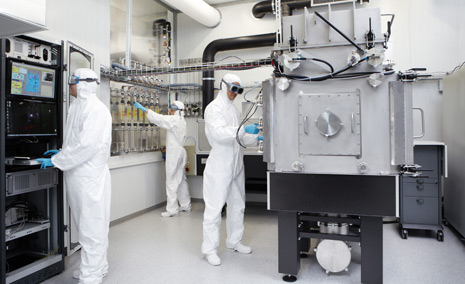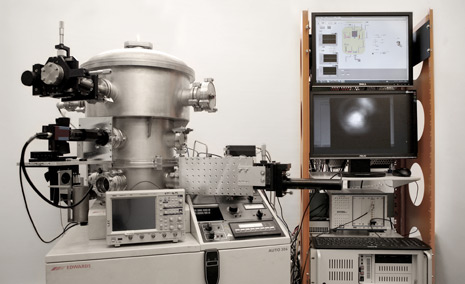Plasma Science
The Applied Laser Plasma Science (“ALPS”) research program, initiated in 2007, focuses on the optimisation of laser-produced plasma light sources that are used in lithography and metrology.
Our research focuses on source optimization ranging from the improvement of the debris mitigation system to the overall source stability in space and time and life time of the source. Furthermore part of the research activities are dedicated to the investigation of the plasma dynamics (in time and space) with several type of diagnostics such as EUV energy monitors, spectrometer operating from the VUV to the visible region and charged particles detectors such as Faraday Cups and Langmuir Probes. A computational code is used to simulate the plasma dynamics proprieties.
Together with EUV we look at the plasma emission properties in other wavelength regions for other applications such as inspection and microscopy with alternative fuels such as indium and gallium.
Research Facility
LEC houses unique facilities that are without equal in most universities and research laboratories. The unique facilities of LEC enable complex experimental and computational projects to be locally performed, over the shortest possible period, with high quality. The experimental facilities in LEC are designed to simulate and test new concepts at full-scale nondimensionals. Advanced test equipment, dedicated test benches, fully automated, data acquisition, processing and storage ensure the quality and timeliness of all test data. A brief description of the available unique facilities is provided below, and more details can be found in the related publications.
The ALPS I facility has been designed in 2007 and is currently operated with a second Nd:YAG laser. This source includes an EUV powermeter mounted on an in-house developed robotic arm, which is capable of measuring the angular distribution of EUV radiation from the source. This second light source is currently employed for plasma characterisation, instrumentation development and laser tuning.

The main LPP source is ALPS II. The facility is operational since February 2013 and is located in our recently built lab. The self-designed source is equipped with a large capacity droplet dispenser and a high power, high repetition rate laser. The Nd:YAG laser, operating at the fundamental wavelength, is currently used to drive the source. The main source is used as an engineering test stand, where long-term effects of source operation are studied. The system will need to accommodate a full-size EUV collector, together with different debris mitigation techniques.
The inertial debris mitigation system utilises collisions between ions and neutral particles from the plasma with a mitigation gas flow. A closed loop droplet positioning system able to keep the droplet target at the main laser focus position (in time and space) has also been developed. Droplet synchronisation in time with the drive laser is the subject of the on-going research.
In the source facilities in order to minimise the effect of debris from the Sn plasma, the mass of the target is reduced to the degree that it is still effective in delivering the sufficient EUV power. This is achieved by dispensing micrometer-scaled droplets. The droplets are then irradiated by a pulsed laser and the EUV emitting plasma is generated. The pulsed laser and the droplets can be synchronised so that only the required target material is delivered. Different plasma diagnostic systems can be used in either ALPS I or ALPS II for measurement of radiation emission and detection of charged particles. Radiation detectors include visible and VUV spectrometers. Charged particle detectors include array of Langmuir probes and Farday Cups’s for plasma angular resolved measurements.

The DTF is designed for experimental research on droplet generation, and consists of a vacuum chamber equipped with sensors and imagining equipment to study the generation and stability of droplets. Lateral and temporal stability of the droplets can be studied by visualising them with two CCD cameras. The illumination of the droplet is accomplished by a high speed flash, triggered simultaneous with the cameras, to allow small expose times and visualisation of single droplets. The images can be post-processed enabling the detection of individual coordinates of the droplets and their diameter. In order to assess the time jitter between each droplet, a laser diode system has been installed as part of the experimental setup. This system enables a highly resolved lateral and drop to drop stability assessment as well as droplet size quantification.
